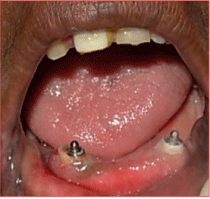
Special Article - Prosthodontics
Austin J Dent. 2017; 4(6): 1087.
Attachment Retained Overdenture on Mandibular Canines
Singh B¹*, Sinha N², Dharmani U³, Tamrakar A4 and Gaurav R
1Department of Prosthodontics, Ranchi University, India
2Department of Orthodontics and Dentofacial Orthopedics, Manipur University, India
3Department of Endodontics & Conservative Dentistry, PGIMER University, India
4Department of Prosthodontics, Jamia Milia Islamia University, India
5Department of Prosthodontics, Kolhan University, India
*Corresponding author: Singh B, Department of Prosthodontics Crown and Bridge & Implantology, Dental Institute, RIMS, Ranchi, India
Received: June 17, 2017; Accepted: July 03, 2017; Published: July 25, 2017
Clinical Image
Overdenture as part of treatment modality for persons with periodontally uncompromised remaining natural teeth has long been advocated with or without the use of attachment. Healthy roots of the intact dentition provide improved retention, stability and support in addition to proprioceptive stimulus and economic and psychological bene ts echoice of attachment for the overdenture is determined by distance and number or location of the remaining natural teeth; however the discretion of the Prosthodontist at times based on his clinical experience is best suited .Patient cooperation is mandatory in terms of hygiene maintenance for its long term success. e mandibular canines are endodontically treated and obturated leaving one-third space in the cervical portion of the root for the attachment.e uni-anchor attachment is placed in the radicular space a er removal of the gutta-percha from the root leaving onefourth of the material in the apical portion, for the placement of the stud attachment within the root surface. GIC is used to lute the attachments with t and parallelism for limiting the path of insertion and removal of the removable prosthesis.

